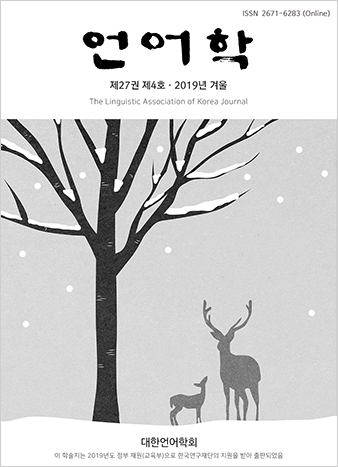대한언어학회 전자저널

-
Anyway as an Unassociative Stance Marker in the American Television Talk Show, Larry King Live
-
Influences of a Native English Teacher and Roles of a Co-teacher on L2 Learners' Learning Styles
-
On the Functions of the Simple Present Tense in The Pilgrim’s Progress
-
Teaching English through Vlogging and In-class Presentation: A Preliminary Comparative Study
27권 4호 (2019년 12월)
- K-Pop 노랫말의 음운 변화 현상
-
서근영 홍성규
Pages : 1-20
Abstract
Keywords
# 케이팝(K-Pop) # 음운 변화(phonological change) # 언어혼종(language hybridization) # 노랫말 발음(lyrics diction) # 이중언어(bilingual language)
References
- 강희숙. (2016). K-Pop 노랫말의 코드 전환 양상 및 담화 기능. 호남문화연구, 60, 193-226.
- 김가람. (2015). 대중가요(K-Pop)를 활용한 한국어 연음 현상 발음 교육 방안 연구. 석사학위 논문, 한국외국어대학교 교육대학원.
- 김옥기. (2019). 한국어 원어민 영어 학습자와 영어 원어민 한국어 학습자의 초분절 요소 습득 경향 연구 (체류 경험 변수를 중심으로). 박사학위 논문, 건국대학교 대학원.
- 박준언. (2015). K-pop 노랫말들의 언어 혼종 (영어 변이형들과 코드전환 사용). 이중언어학 61, 95-124.
- 박준언. (2014). K-pop 노랫말 코드전환의 기저언어 설정. 이중언어학 54, 157-184.
- 서빛나래. (2018). 다양한 대중음악 장르의 표현에 따른 한국어 딕션 방법에 대한 연구 (영어 자음과의 비교분석을 중심으로). 석사학위 논문, 단국대학교 문화예술대학원.
- 신영길. (2018). 뮤지컬 가창을 위한 가사의 음운론적 연구 (우리말 가사의 초분절음 분석을 중심으로). 석사학위 논문, 홍익대학교 공연예술대학원.
- 오은진. (2015). 외국어 음성 체계. 서울: 한국문화사.
- 유미란. (2012). 한국 대중가요 가사 발음의 올바른 사용을 위한 연구. 석사학위 논문, 경희대학교 아트퓨전디자인대학원.
- 이수안. (2012). 유럽의 ‘한류’를 통해 본 문화혼종화 (K-pop 열풍을 중심으로). 한독사회과학논총, 22(1), 117-146.
- 한국사회언어학회. (2012). 사회언어학 사전. 소통
- 황승경. (2012). 뮤지컬 가창에서 한국어 발음의 음성학적 연구. 박사학위 논문, 성균관대학교 일반대학원.
- 2018 음악산업백서. (2019). 한국콘텐츠진흥원.
- Flege, J. E. (1995). Second language speech learning (theory, findings, and problems). Baltimore, MD: York Press.
- Jespersen, O. (1904). Lehrbuch der phonetik. B. G. Teubner.
- Trofimovich, P., & Baker, W. (2006). Learning second language suprasegmentals (effect of L2 experience on prosody and fluency characteristics of L2 speech). Studies in Second Language Acquisition, 28(1), 1-30.
- William, L. (1979). The modification of speech perception and production in second-language learning. Perception and Psychophysics 26(2), 95-104.